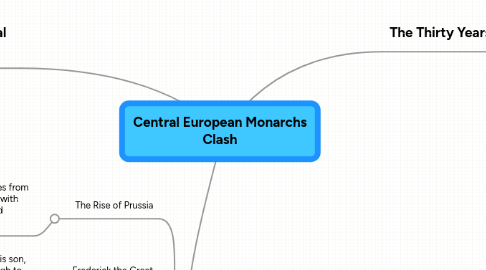
1. States Form in Central Europe
1.1. Economic Contrasts with the West
1.1.1. The economy of central Europe developed differently from that of western Europe.
1.1.1.1. Serfs slowly won freedom and began moving into towns with the middle class
1.2. Several Weak Empires
1.2.1. Nobles in central Europe held down the serfs but also blocked the developed of strong knights.
1.2.1.1. After the Thirty Years' War the Holy Roman Empire had no real power in Germany.
1.3. Austria Grows Stronger
1.3.1. Hapsburgs of Austria took several steps to become absolute monarchs.
1.3.1.1. First step, conquered Bohemia.
1.3.1.1.1. Second step, they centralized the government and created a standing army.
1.4. Maria Theresa Inherits the Austrian Throne
1.4.1. Charles VI persuaded other leaders of Europe to sign an agreement that declared that they would recognize Charles's eldest daughter as the heir to all his Hapsburg territories.
2. Prussia Challenges Austria
2.1. The Rise of Prussia
2.1.1. The Hohenzollerns built up their states from a number of small holdings, begining with the German states of Bradenbrug and Prussia.
2.1.1.1. Prussia's landowning nobility, the Junkers, resisted the king's growing power.
2.2. Frederick the Great
2.2.1. Frederick William worried that his son, Frederick, was not military enough to rule.
2.2.1.1. In 1730 him and his friend tried to run away but was caught. To punish him, the king ordered him to witness his friend's beheading.
2.2.1.1.1. Despite the memories, Frederick became known as Frederick the Great, followed his father's military policies when he came to power.
2.3. War of the Austrian Succession
2.3.1. 1740, Theresa succeeded her father, just five months after Frederick II became king of Prussia.
2.3.1.1. Theresa and Frederick went to war over Silesia, which bordered Prussia.
2.3.1.1.1. Theresa lost Silesia in the Treaty of Aix-la-Chapelle in 1748.
2.4. The Seven Years' War
2.4.1. In 1756, Frederick attacked Saxony, an Austrian ally.
2.4.1.1. Soon every great European power was involved in the war.
2.4.1.1.1. Took place in Europe, India, and North America. Lasted til 1763.
3. The Thirty Years' War
3.1. Bohemian Protestants Revolt
3.1.1. Ferdinand II was head of the Hapsburg family and he was future Holy Roman emperor and he ruled the Czech kingdom of Bohemia.
3.1.1.1. The protestants in Bohemia did not trust Ferdinand because he was a foreigner and a catholic.
3.1.1.1.1. When Ferdinand closed several protestant churches he made the protestants revolt against him and sparked the thirty years war.
3.2. Hapsburg Triumphs
3.2.1. The thirty years war lasted from 1618-1648. The first 12 years the Hapsburg army from Austria to Spain crushed the troops hired by the Protestants princes.
3.2.1.1. Ferdinand allowed his army to plunder, or rob, German villages.
3.3. Hapsburg Defeats
3.3.1. Gustavus Adolphus and his army of 23,000 shifted the tide of war in 1630.
3.3.1.1. They drove Hapsburg armies out of northern Germany. Gustavus was killed in battle in 1632.
3.4. Peace of Westphalia
3.4.1. Ended the war in 1648.
3.4.1.1. Weakened the Hapsburg states of Spain and Austria
3.4.1.1.1. Strengthened France by awarding it German territory
3.5. Begining of Modern States
3.5.1. Recognized Europe as a group of equal independent states. Most important result of the Thirty Years' War
